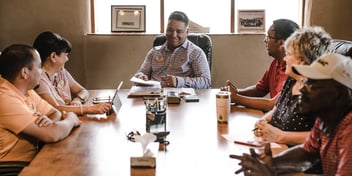Chances are, you have employees of all different ages working for you—especially if you have a relatively large workforce. With these varied ages comes a diverse set of skills, personalities, expectations, aspirations, and so much more. You may not know all of these employees personally, but it’s important to understand what your employees want and need on the job and in training.
Many employees may not even care about training, and there may be some who actively seek out new knowledge. Whatever the case, your company’s safety training needs to accommodate and engage all of your employees, personality differences between generations.
You’re guaranteed to have unique training needs for a multigenerational workforce of any size, so it’s important to understand what those needs are and how you can address them. Check out some of these great tips for presenting safety training to your multigenerational employee base.
Contextualize
The first thing you need to do is put everything into context.
Are you getting a new training platform? Tell them why.
Are they learning about a new topic? Explain its relevance.
Is there a refresher training after an incident? Convey the importance.
Putting your training into context for all of your employees helps to give them a foundation of understanding. Having a solid preliminary understanding helps to build knowledge and tie things together. Safety training is no good if no one is learning from it.
No matter which generation you’re addressing, you should always provide context for the content you deliver. Your employees—baby boomers and millennials alike—aren’t a herd of sheep to be corralled into classrooms. They’re intelligent individuals who will succeed if you give them the resources and effort.
Conversationalize
Communication seems like such a simple skill, but it’s often the cause of many problems throughout the workplace and even throughout the world. It can be frustrating when employees and leadership aren’t on the same page or when their communication styles don’t align.
There’s no point in using overly complicated language. Being unnecessarily formal only creates tension. The problem is that management often feels a need to present themselves in a more “respectable” manner, which displays itself in speech. But being professional doesn’t have to be incomprehensible.
Using conversational language will appeal to all of your employees. Baby boomers will appreciate being talked to as an equal, Generation X will appreciate the straightforwardness, and millennials will appreciate the efficiency of clear and concise language. All of your management-employee communications should be easily understood by everyone.
Connect
We often give out implied information—that is, we don’t state outright all of the things that we mean to convey. As a leader, in order to make sure everyone is following the same thoughts, you should strive to explain things as thoroughly as possible. State what you may think is obvious. Leave no doubt about your meaning.
Especially with safety training, it is also crucial to make other kinds of connections—like providing practical examples and hands-on learning to accompany theoretical knowledge. Help employees make connections between textbook knowledge and on-the-job practices.
The training needs for a multigenerational workforce really aren’t that complicated. You just need to remember what kinds of things will appeal to everyone across the generations. The importance of effective communication cannot be emphasized enough.
Talk to your employees and find out what works and what doesn’t. You might be surprised to find out that many employees will tell you what they expect, what they appreciate, and what they struggle with. Addressing these things will put you well on your way to not only managing a multigenerational workforce better but also improving your safety training program and culture.



%20(1).jpg?width=352&name=the%20holmes%20family%20(1)%20(1).jpg)


Leave a Comment